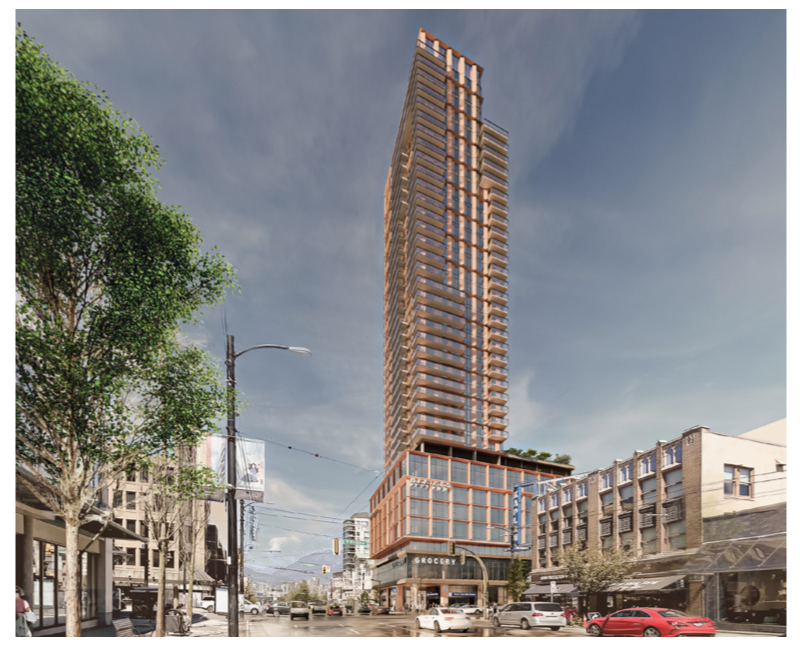Â鶹´«Ã½Ó³»city council voted 9-2 Tuesday to approve the construction of a 39-storey rental tower at the northeast corner of Broadway and Granville that will be integrated with a new subway station under construction on the property.
When complete, the 407-foot tower will be one of the tallest buildings on the south side of False Creek and feature 223 rental homes, with 45 of them to be rented at below market rates.
A city staff report described the development as “an urban placemaker.”
“I think it’s actually quite a handsome building,” said Coun. Pete Fry during his remarks in support of the project, the first of its kind to be built over a station serving the new subway line under construction from the False Creek Flats to Arbutus Street.
A large grocery store and office space will occupy the lower floors of the tower, which will be built by PCI Developments LP, the same developer with two 14-storey rental tower in the 3600-block of East Hastings Street.
90 speakers
Council’s decision Tuesday came after hearing from 90 speakers over several nights of a public hearing, with those in support and opposed to the project evenly split, according to results tracked by city staff.
Supporters focused on the need for more rental housing, particularly on transit lines, and more family-sized homes; a minimum of 35 per cent of all rental units will be two or more bedrooms.
Those opposed cited scale and height of the project, with many noting the proposal shouldn’t be considered until the Broadway Plan goes before council next month.
Council also received 409 letters against and 607 in support of the tower, including one from BC Attorney General David Eby, who doubles as the province’s housing minister, and another from BC’s Environment Minister George Heyman.
It is a rare move for cabinet ministers to send letters to city hall on a project.
“The development of a mixed-use buildings such as this one, which bring density to areas surrounding rapid transit stations, are generally accepted as best practice in urban design, as well as optimal utilization of transit infrastructure,” Eby said.
“Accordingly, the Province is actively supporting proposals of this kind, which align and support government’s affordable housing, climate change and transportation infrastructure goals.”
'Cart before the horse'
Coun. Colleen Hardwick unsuccessfully attempted to postpone debate on the project, suggesting council should first review the much-anticipated Broadway Plan, which will outline future development possibilities along the corridor.
Hardwick said the project was “leapfrogging” the Broadway Plan and said approving it under an interim city policy would be “putting the cart before the horse.” Postponing debate would have restored trust in the city’s engagement process with residents, she said.
“The public trust has been seriously eroded through this,” said Hardwick, who is TEAM for a Livable Vancouver’s mayoral candidate in the Oct. 15 election.
“I'm concerned that we are pushing through profound changes during a pandemic, when we really should be pressing pause and going through this systematically.”
Coun. Jean Swanson cited affordability in her reasons for not supporting the tower, saying it didn’t serve low-income renters.
“With this project, we have 20 per cent affordable to people in the 50 to 80K range,” Swanson said. “Nothing for people below that, nothing for the median senior household income of 28K, nothing for people on disability, or [people] on social assistance, or a single minimum wage earner, or students working part time.”
'Towers are not unlivable'
Coun. Adriane Carr pushed back on Hardwick’s framing of the vote that it was putting the cart before the horse, noting it was a council-approved interim rezoning policy that allowed the project to come before council.
“I don't believe it'll set a precedent for the Broadway Plan,” Carr said. “City staff just told us today that in fact the Broadway Plan is in draft form already. So it's not the cart before the horse.”
In supporting the project, Carr pointed out the increase in rental housing, the proximity to transit and how the tower will be built to produce 95 per cent fewer emissions than current buildings of its size and shape.
She challenged some critics concerned about another tower being built in Vancouver. She noted she lived in the West End, where there is a high concentration of towers.
“The livability of the West End is unbelievable,” Carr said.” The towers are separated — there's not walls of towers…and in between, you get older character homes that are 100 years old, you get three-storey buildings, you get six-storey buildings, eight-storey, I mean, there's a real mixture.”
Added Carr: “Towers are not unlivable. I wouldn’t live in one, it’s not my choice. But the people who live in them, love them.”
Transit-oriented development?
Although councillors Pete Fry and Rebecca Bligh voted in favour of the tower, both cited concerns about the need for 300 parking spaces in what is supposed to be a development designed to have more people use transit instead of vehicles.
Fry: “I'm still struggling with the six levels of parking for up to 300 cars on what we're calling transit-oriented development. We need to do better. I know that this is meeting the policy, but we need to move our policy.”
Bligh: “I absolutely agree the parking is a mistake.”
The project will take several years to build, but its completion is anticipated to coincide with the opening of the South Granville subway station at the end of 2025.
@Howellings




